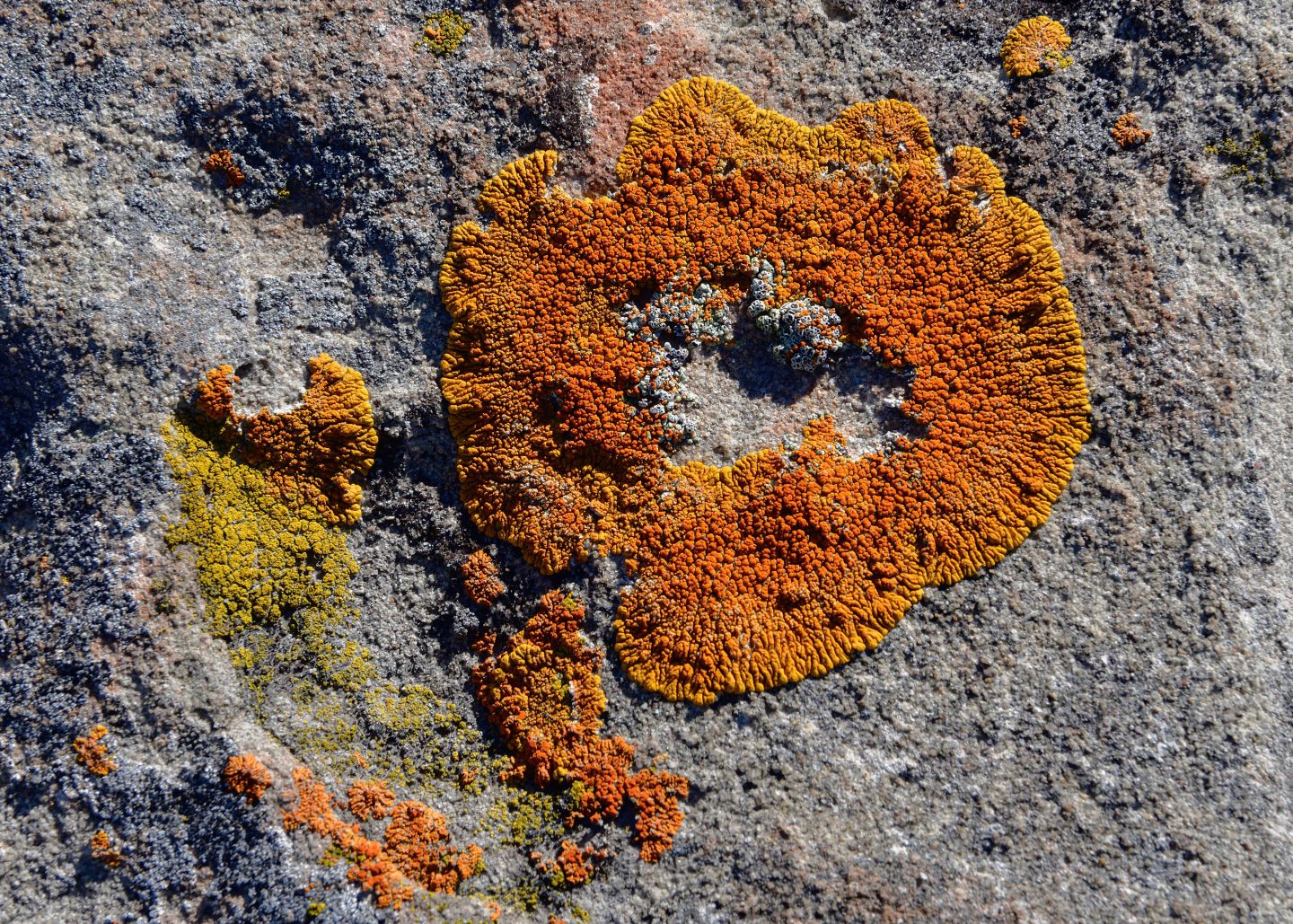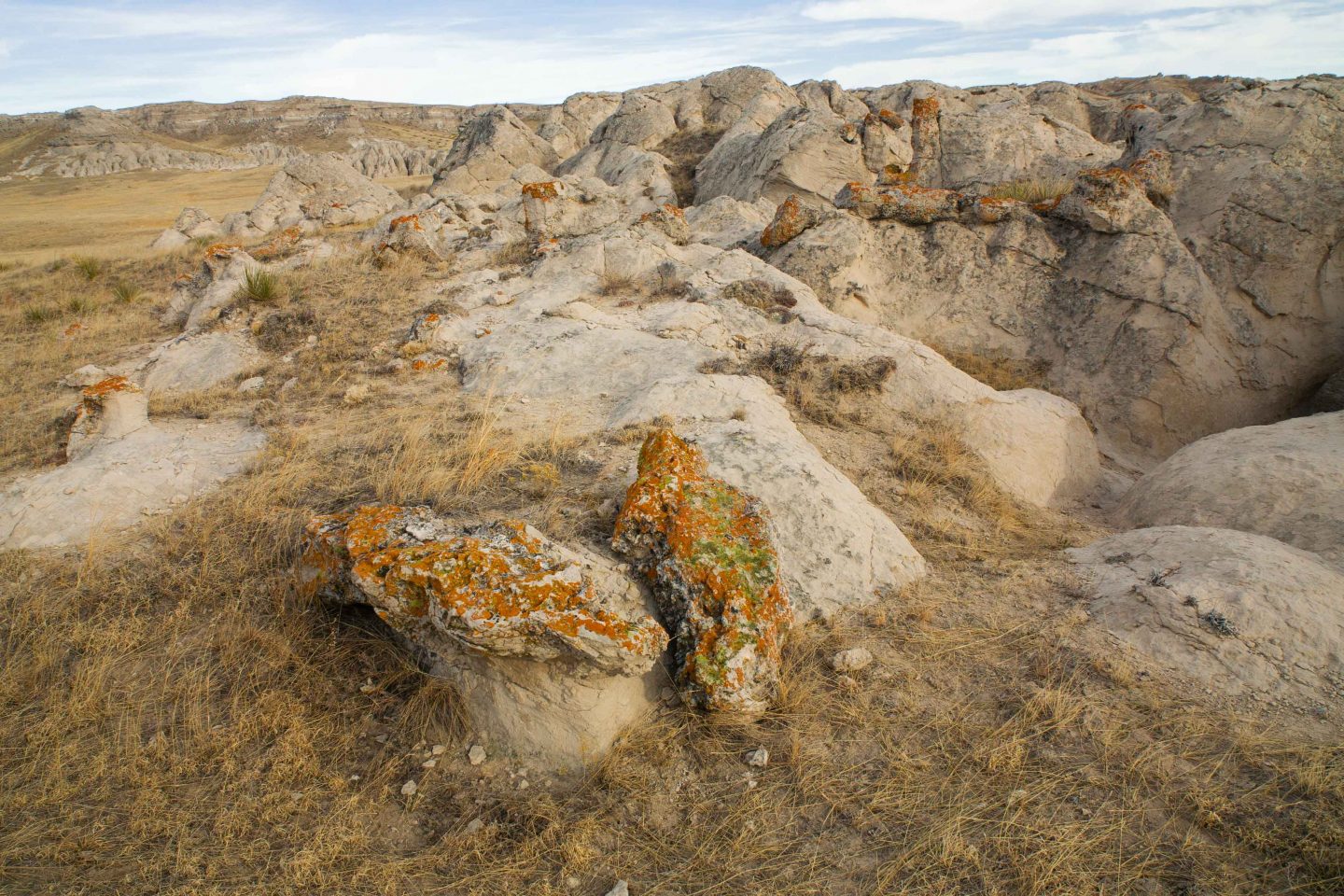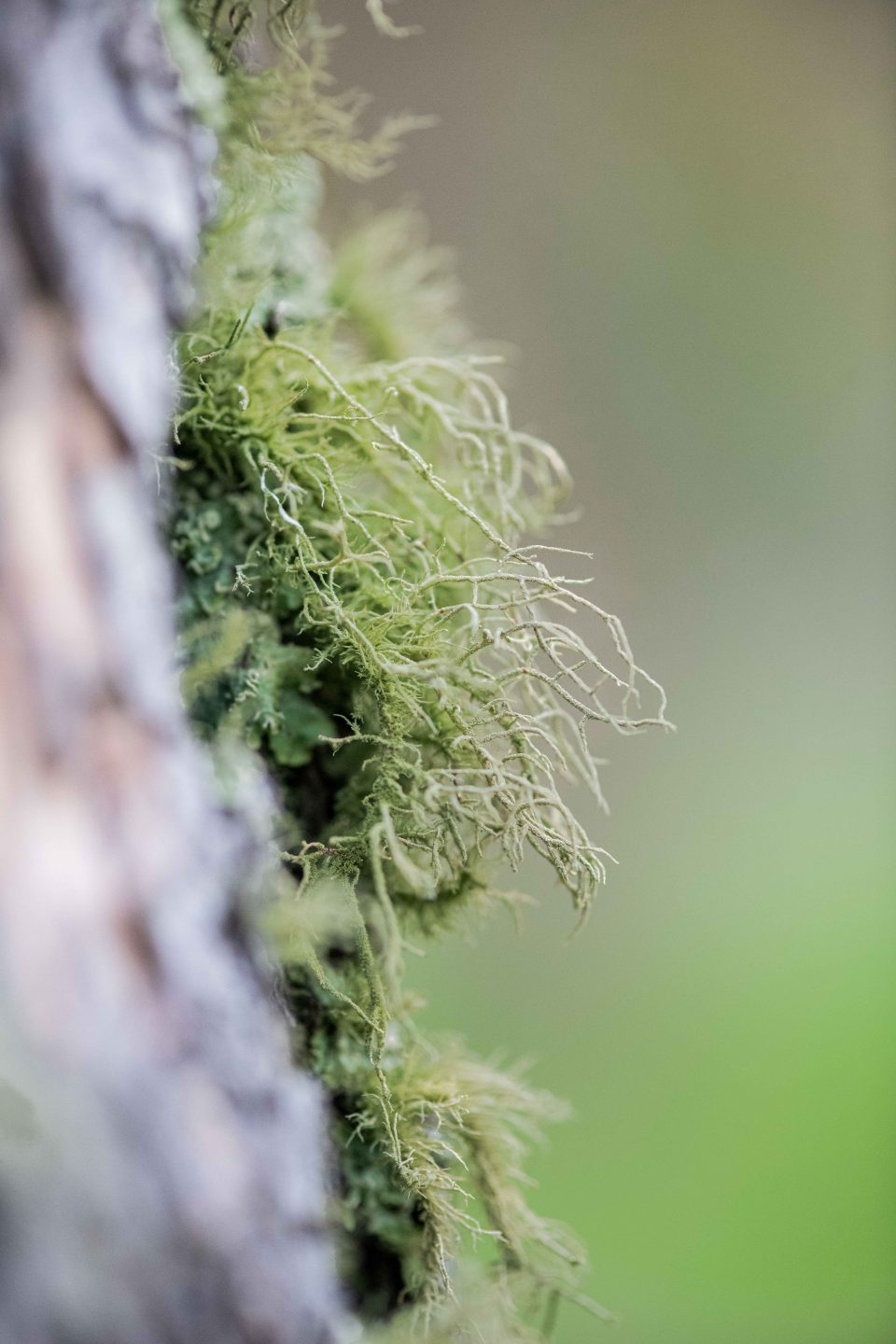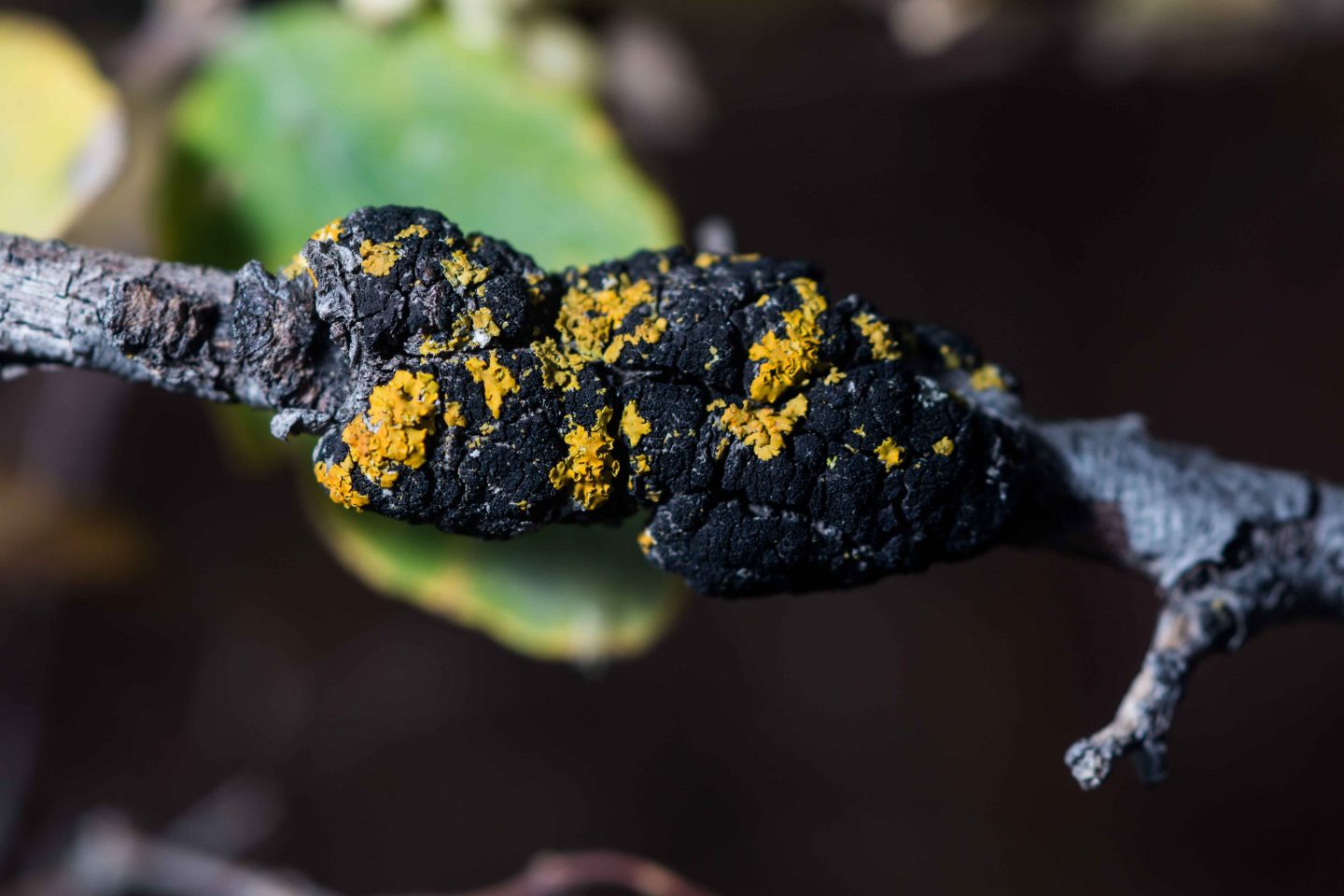
By Monica Macoubrie, Wildlife Education Specialist
Lichens aren’t exactly showstoppers. They don’t flutter through the air like butterflies or make bold calls at dawn like songbirds do. Most people pass by them completely unaware. But once you start noticing them — clinging to rocks, dotting tree bark, spreading like tiny maps across old wooden fences — it becomes hard not to see them.
Although lichens are some of Nebraska’s quietest residents, they have fascinating stories to tell, especially about the air we breathe and the resilience of life in tough places.
What Is Lichen?
Well, it’s not a moss. It’s not a plant. And despite its sometimes flaky, crusty appearance, it’s definitely not mold growing on a rock.
Lichen is actually a partnership — a biological alliance where two different organisms come together and make a life that neither could manage alone. It is a symbiotic relationship between a fungus and either an algae or a cyanobacterium.
Think of lichen as nature’s ultimate buddy system: the fungus builds the “house” — it provides the structure, holds moisture and protects its partner from the harsh world outside. Meanwhile, the algae or cyanobacteria act like the live-in chef, photosynthesizing to create food from sunlight, which they share with the fungus.

It’s a pretty impressive arrangement. The fungus can’t photosynthesize, and the algae or cyanobacteria can’t survive the environmental extremes that the fungus can shield them from. But when they team up, they can grow on bare rock, rusty metal, sun-scorched bark, old gravestones … you name it. That’s why we find lichens in places where most other living things would throw in the towel.
And here’s the kicker: Lichens aren’t just one species. Each lichen you see is actually a community — a functioning unit made up of at least two organisms, sometimes even more. Some lichens host additional bacteria that help with processes like nitrogen fixation, which makes them even more self-sufficient and important to their ecosystems.
Tough Little Survivors
You’ll find lichens all across Nebraska, from growing on shady cottonwood trunks along the Missouri River to sun-baked limestone outcrops in the Sandhills. They grow slowly — some less than a millimeter per year — but they’re incredibly tough. Some species can withstand freezing temperatures, drought and even radiation.
Nebraska is home to a surprisingly rich diversity of lichen species — over 300 documented so far, and there are likely more waiting to be discovered. Some form thin, tight crusts on stone that almost looks like old paint, called crustose lichen. Others are looser and leafier, curling up at the edges like old lettuce, called foliose lichen. And then there are the bearded ones — those shrubby, hair-like forms that dangle, resembling gray-green beards on tree limbs, known as fruticose lichen.
The variety among lichens is stunning once you start paying attention. My daughter and I like to “hunt” for them on hikes, especially in places we’ve visited a dozen times. When you slow down and look closely, it’s like discovering a whole new layer of the landscape. We’ve spotted mint-green rosettes growing like frost on fallen logs and pale orange patches spreading like sunbursts on wooden fence rails. Searching for lichen is a low-key treasure hunt, the kind that doesn’t require any gear — just your eyes, your curiosity and a willingness to slow down.

Lichen as Environmental Indicators
Lichens have the ability to “speak” for the environment. They don’t have voices, of course, but if you know how to read them, they’ll quietly tell you a lot about the air we’re all breathing. Because lichens don’t have roots, they don’t draw nutrients from the soil like plants do. Instead, they absorb everything — water, minerals and pollutants — straight from the atmosphere. That makes them incredibly sensitive to air quality, especially to substances like sulfur dioxide, ammonia and nitrogen compounds from vehicle exhaust, power plants or heavy fertilizer use.
In cities or areas near large-scale agriculture, it’s not uncommon to find only a few tough, pollution-tolerant lichen species — ones that can hang on in conditions where others simply can’t survive. These lichens might be smaller, duller in color or crustose types that hug tightly to stone and bark. But in rural areas, especially where there’s cleaner air like in the Sandhills, Niobrara Valley or along stretches of the Missouri River, you’re more likely to spot a diverse mix of lichen types in all shapes, colors and textures. It’s like nature’s way of quietly waving a green flag, saying “things are healthy here.”

Scientists may use lichens to monitor air quality in places where they might not have the equipment to record data. By noting what species are present — and which ones are missing — they can get a sense of long-term environmental shifts. Due to their slow growth, lichens are like “biological journals” etched into bark and stone.
Some states even use lichen studies to guide conservation decisions or track the impact of industry and urban development. While Nebraska doesn’t currently have a statewide lichen monitoring program, the potential is there. These tiny organisms are like living sensors that cost nothing to maintain and can survive in the most remote places, just quietly keeping tabs on the air around them.
Part of Nebraska’s Wildlife Web
Beyond their roles as air quality indicators and tough survivors, lichens are also an important — though often overlooked — part of Nebraska’s wildlife web.
Tiny birds, such as hummingbirds, vireos and gnatcatchers, use lichens as camouflage for their nests. They’ll carefully collect pieces of foliose lichens and press them onto the outside of their homes, blending them seamlessly into tree bark. It’s a natural disguise that helps hide vulnerable eggs and chicks from predators. I’ve seen hummingbird nests that looked like mere knobby patches of tree branch, only revealed by a blinking bird.

Small mammals, such as voles and shrews, may collect lichens as bedding for their underground nests and burrows, adding it to the grasses, leaves and mosses they use for insulation. In some cases, lichens may even serve as a source of antimicrobial protection, keeping nests a bit cleaner.
And during Nebraska’s long, harsh winters, food can be scarce, especially out in the Sandhills or Pine Ridge, where snow can blanket everything for weeks. That’s when lichens become forage for wildlife, such as deer, elk and even pronghorn. Though not particularly high in nutrients, lichens are better than nothing when grasses and forbs are buried underneath snow. In northern climates, caribou and reindeer rely heavily on certain fruticose lichens, often called “reindeer moss,” as a winter staple. While we don’t have caribou in Nebraska, the concept holds: When times are tough, lichens can help fill the gaps.
Lichens also play an indirect but vital role in the ecosystem. They help break down rocks into soil, stabilizing thin soils on cliffs and outcrops and contributing organic material as they grow and decompose. Some types even fix nitrogen, enriching the soil in areas where other plants might struggle to gain a foothold. This is especially helpful in recovering prairie or rocky outcrop ecosystems, where building up soil health is a slow, long-term process.

Seeing the Unseen
They may not be flashy. They don’t bloom, buzz or chase prey. Nevertheless, lichens are busy behind the scenes feeding wildlife, hiding nests, forming soil and quietly keeping ecosystems stitched together.
Are lichens going to steal the spotlight from elk or bald eagles anytime soon? Probably not. But they deserve a little more love than they usually get. They’re survivors, collaborators and storytellers — living proof that even the smallest organisms can play big roles in the ecosystem.
So next time you’re out for a walk, whether that’s in a state park, your backyard or even downtown, take a moment to pause and look a little closer.
